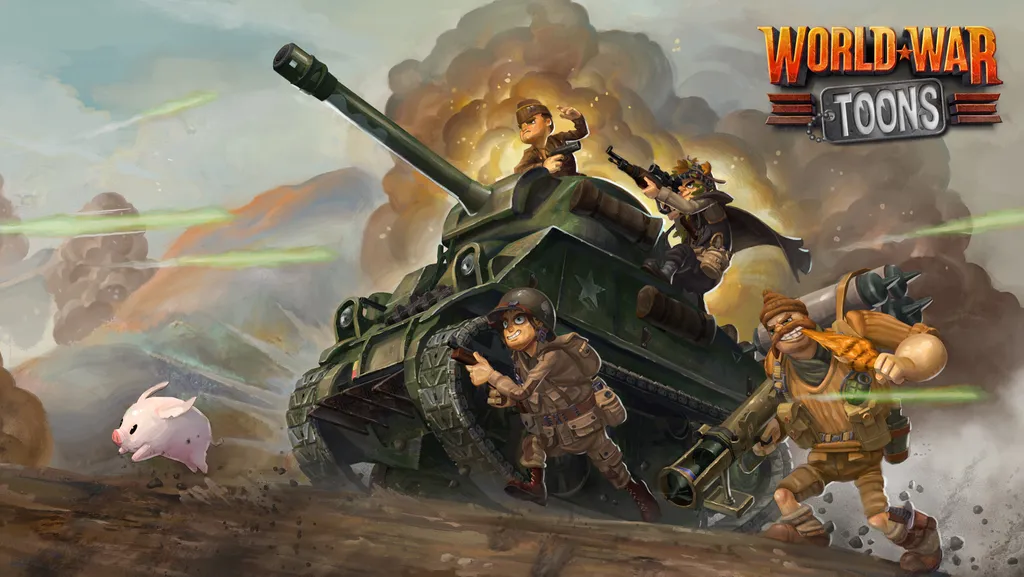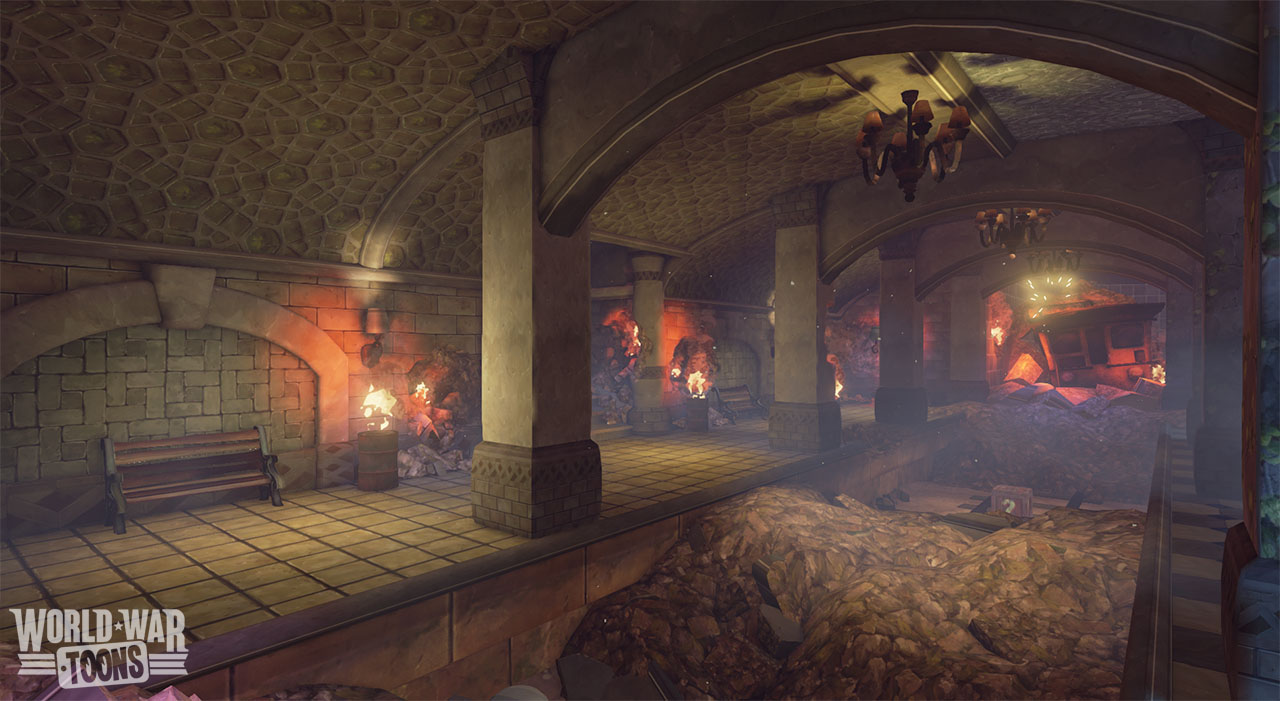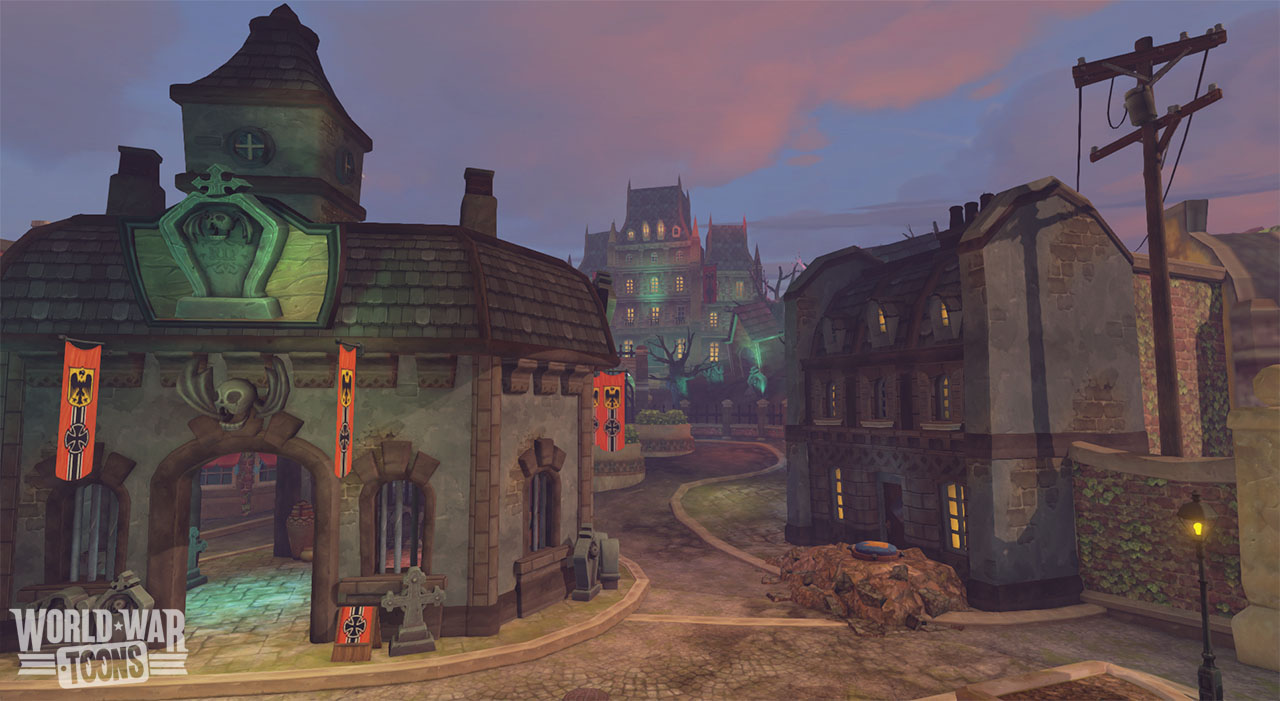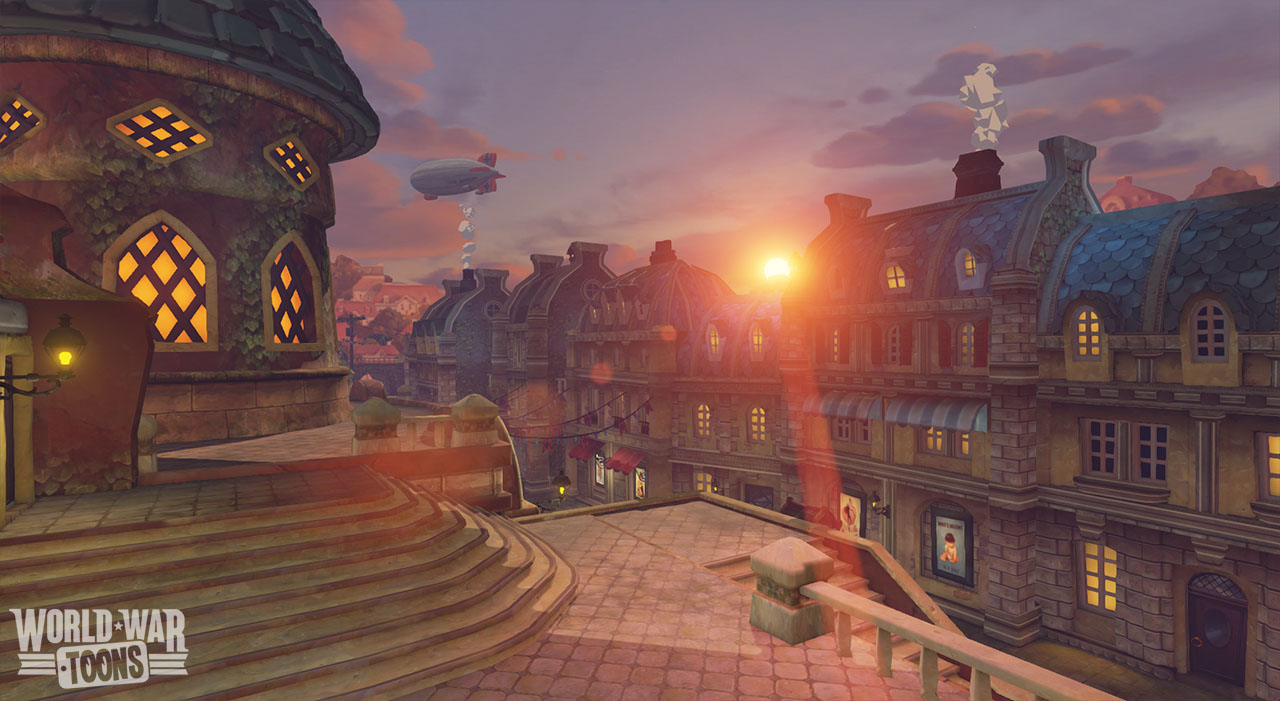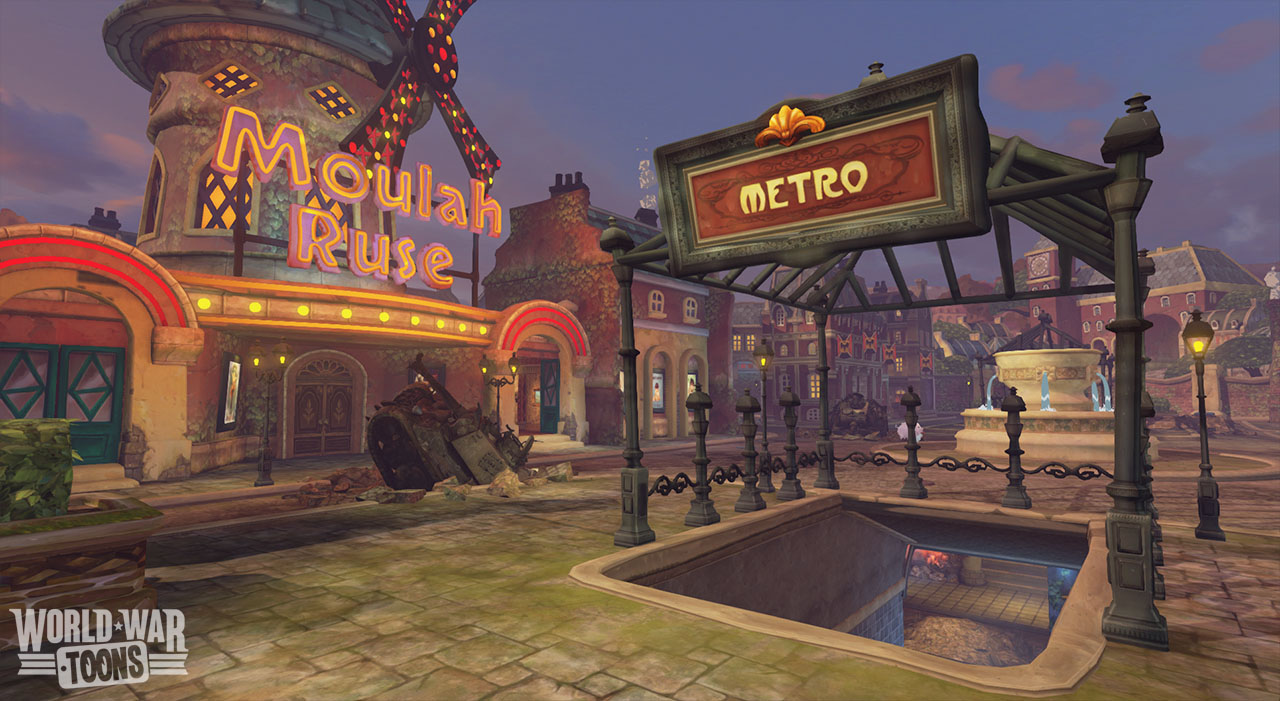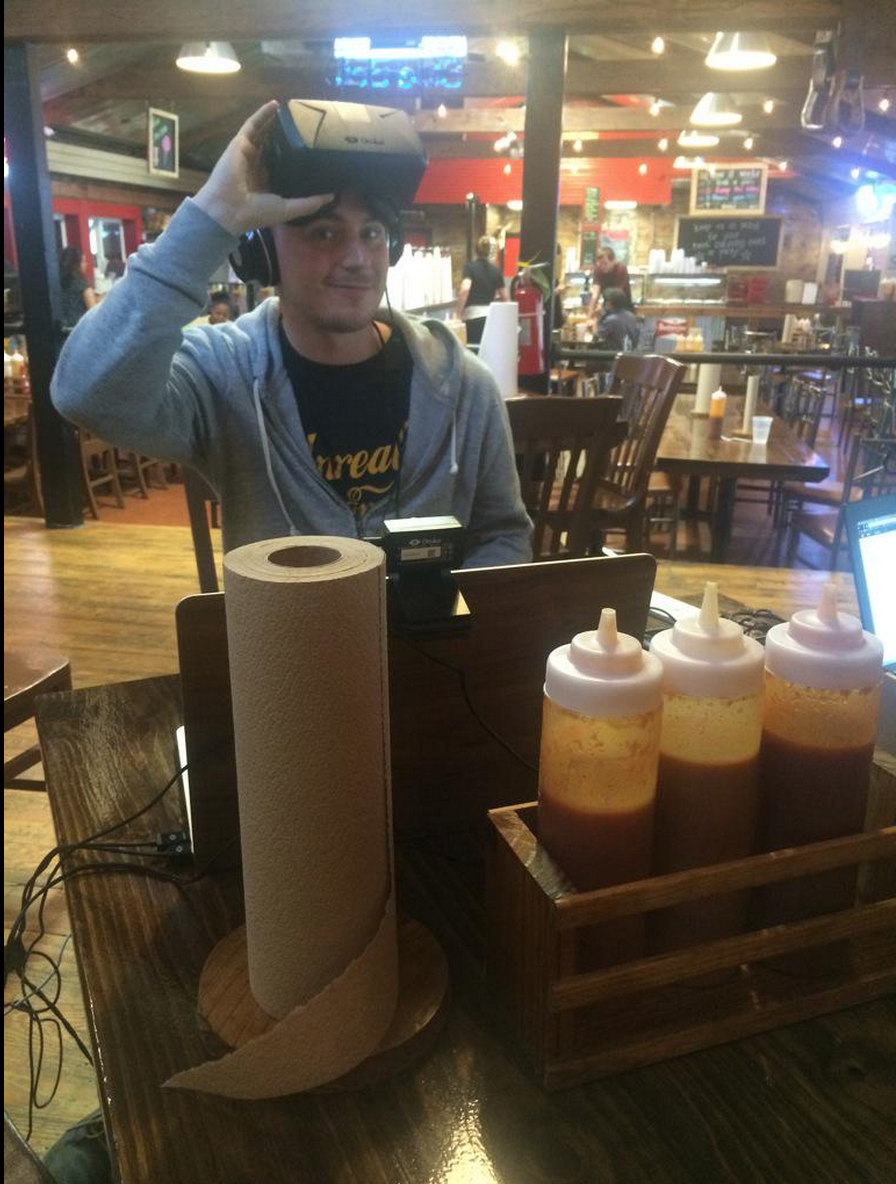
I’ve tried VR in some fairly unconventional places, but perhaps this was the strangest. We were in Austin, Texas checking out all the SXSW festivities and VR news at the event and it was our last day. We had just headed into Austin from our rental house (i.e. ‘the VRHaus’) which was nestled an ever so convenient hour away from the city proper. I had an online play test scheduled for 4pm, something I was more than well aware of when my stomach began to growl in the car. With only 45 minutes until the start of the play test the executive decision was made, we were going to try and do this in a BBQ joint because there simply wasn’t time to make it to two places in SXSW traffic.
I’m sure you can imagine the confused faces as we began standing on chairs looking for outlets as I set up my laptop and DK2. Thankfully, the place wasn’t too full at the time, and I was able to play relatively undisturbed, aside from one group of festival goers who were… thoroughly enjoying their time at SXSW and decided to sit at the table behind “the guy with the funny looking mask.” Finally set up, albeit with wonky wi-fi, it was time to dive into Reload Studios new game, World War Toons, a multiplayer first person shooter set in WWII.
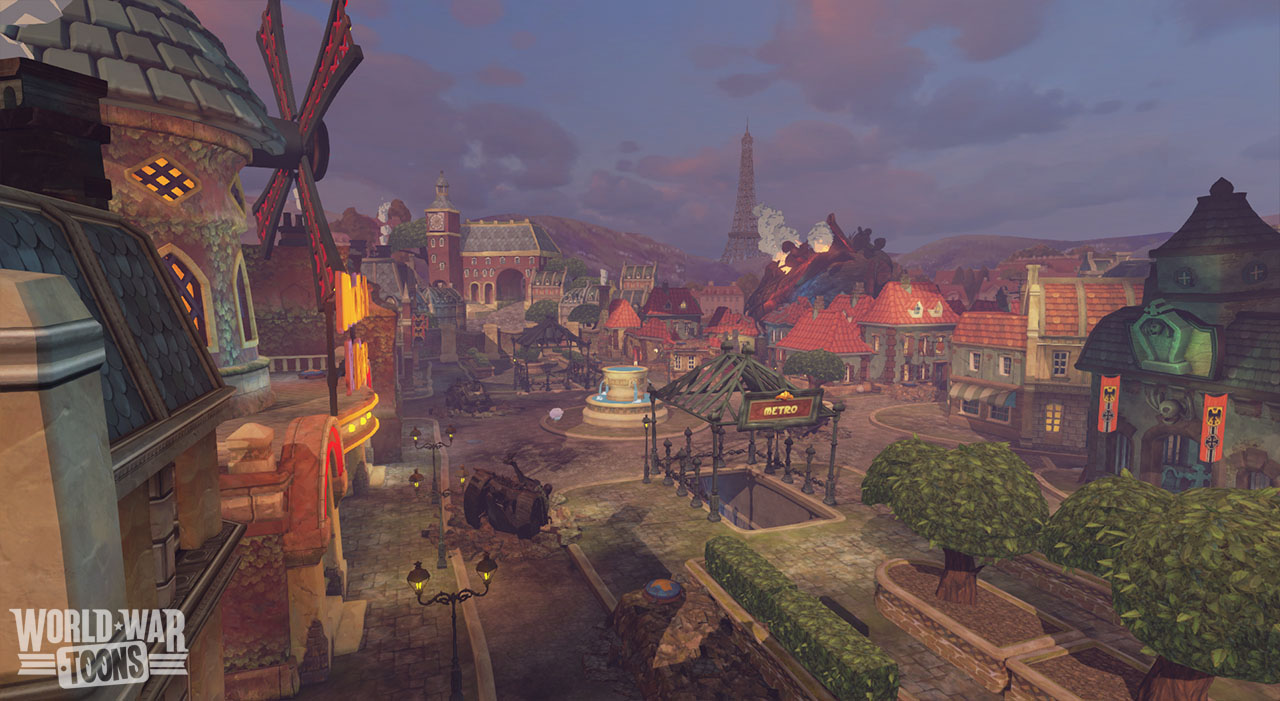
When I first had a chance to see the game, it was much earlier along in the build, it was very barebones and while the current pre-alpha is still far from finished it shows the promise to be the best FPS currently available in VR (non-cockpit category). Coming from a team of Call of Duty veterans the game is not exactly what the trailer led you to believe. The art style is playful and cartoonish, partially the result of animation director Nik Ranieri’s prior experience at Disney, where he worked as an animator on films like Aladdin, Hercules (the good one), and Pocahontas.
In VR especially, this game looks amazing but the art direction is not just for looks, it is utilitarian as well. “Going cartoony gives us tremendous room to bend rules,” says Reload founder, James Chung “we can work with a lot of different things that will help us to make the game more fun and also make it better for VR.” The strategy works extremely well as design elements no longer bound to realism allowed the developers to experiment with new tactics for dealing with motion sickness issues that plague many VR FPS’s (especially those without some sort of helmet around you). For example, one common thing that can lead to sim sickness are drops and jumps, two things fairly ubiquitous in first person shooters, in World War Toons the game makes use of the cartoonish art direction to solve this problem. Whenever your character drops down his helmet balloons out, like a parachute, and slows your fall speed allowing you to gracefully without jarring your stomach. This also contributes to the gameplay, as it allows for ‘jump pads’ and zip lines on the map which catapult the player around the map, giving you plenty of air time to get off some sweet aerial kills and add to the zany nature of the game.
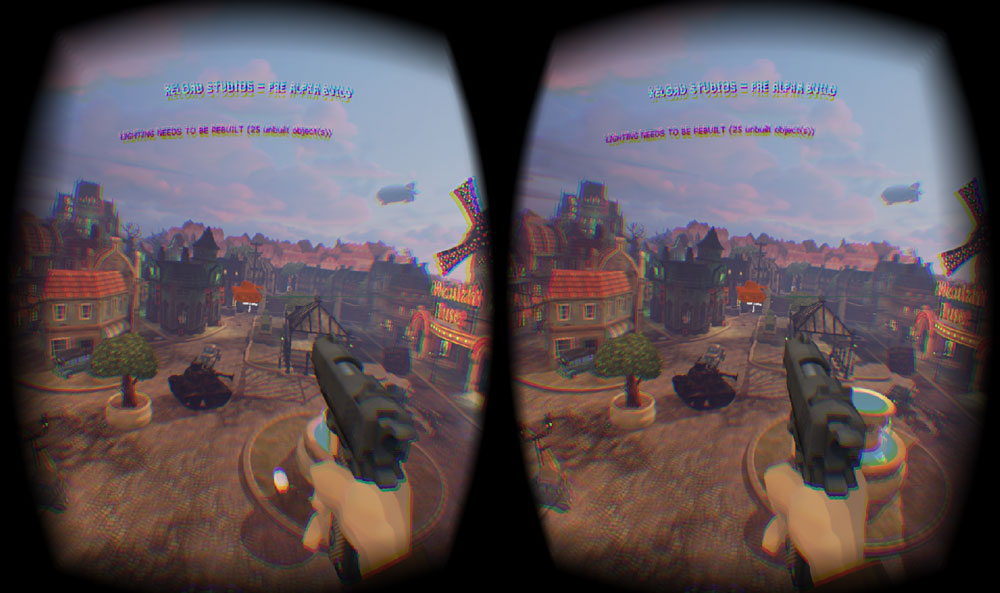
One other issue in VR that the art direction helps is a lack of a mini map. In first person shooters it is vital to know where the action is, and to have a vague idea of where your enemy is. In VR it is incredibly difficult to design a user interface that not only fits the style of the game but functions well in the headset. Rather than going with a mini map to tell you where the action is, when players die in game their ghost dons some angel wings and floats up into the sky. This is not only a cute animation effect, it also allows players to effectively position where the action is currently happening. This is an extremely elegant solution that is as functional as it is fun, as Chung told me “we want to make a game that is just pure fun and makes people laugh,” and that they did.
Another thing that was a challenge was finding a way to cue in the player as to their health situation. The non-VR version (because even a game “built from the ground up for VR” needs a flat version right now to have a broad reach) of the game has a health bar, but that doesn’t work as well in VR. Instead they put in a mechanic that greys you out as your health goes down. This is a subtle cue that works well.
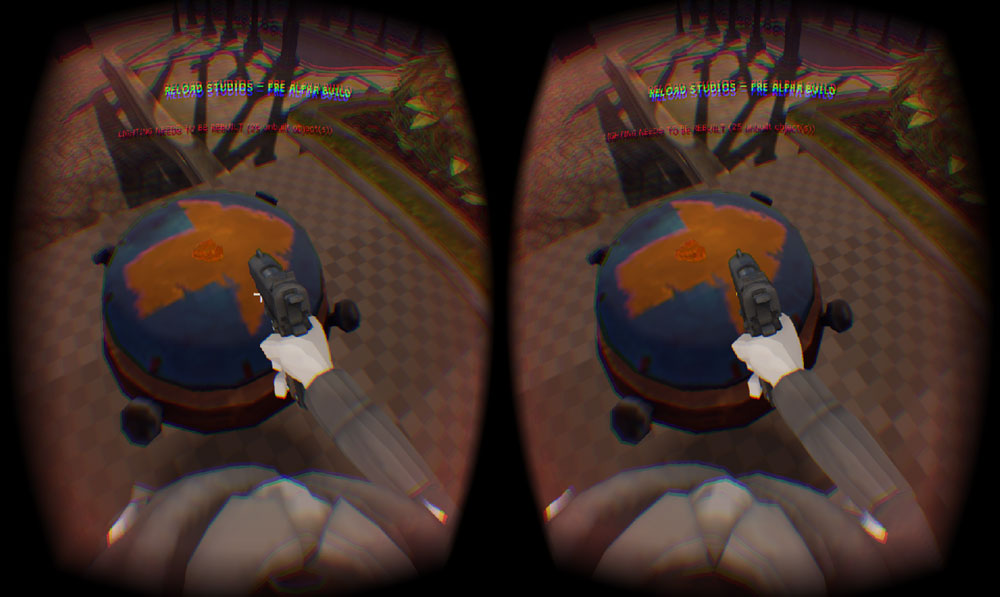
The game is chock full of playful allusions to cartoons like Looney Toons, for example when you are running around the map (at least the one that I was shown) there are a number of manhole covers that dot the streets. Occasionally a shadowy figure with big blinking cartoon eyes will poke his head out from the manhole, according to James he may eventually also drop power ups.
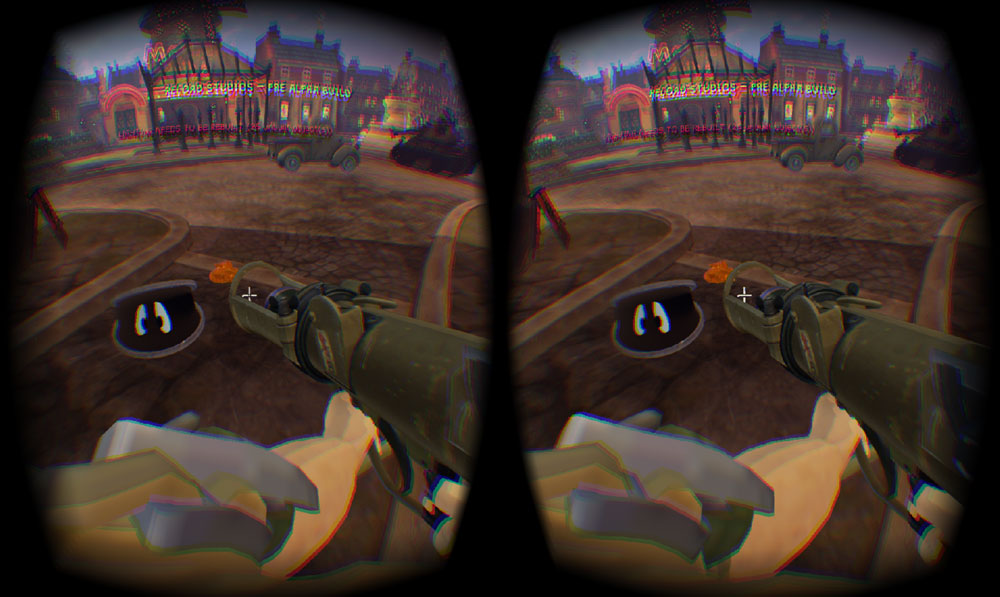
Beyond the game’s beautiful art direction, the gameplay itself is very fun. The pacing is slowed to a point where it feels good in VR, but not to a point where it feels too slow. This change in speed not only makes the game much more comfortable, it also makes it far more accessible. Speaking to James during my first visit, he told me that he wanted to make a game that was more approachable than Call of Duty had become, a game where a casual gamer can pick it up and not die every 30 seconds. The game’s pacing enables this but it is all of the other elements that give this game a number of layers of depth.
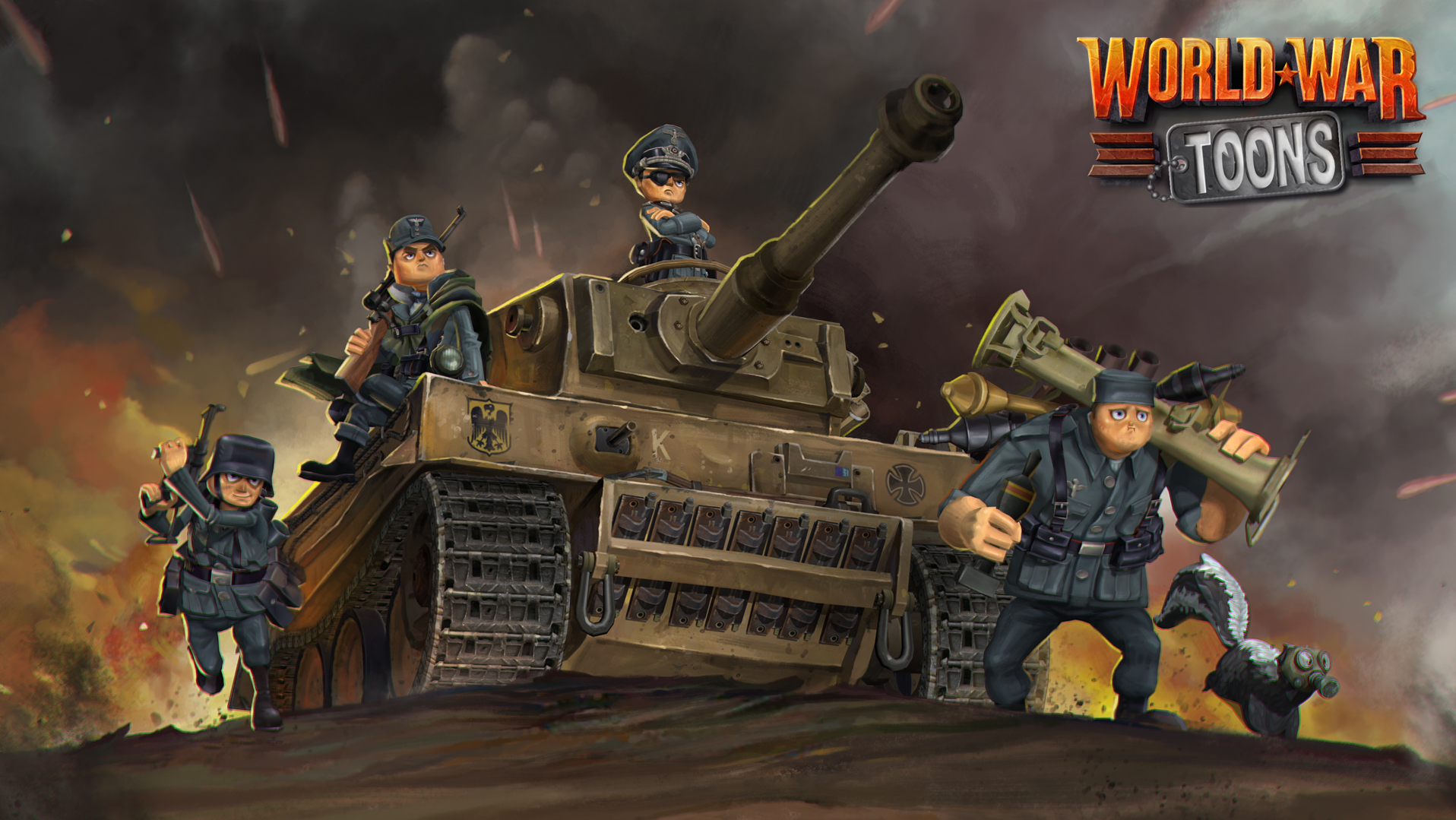
As of right now there are three different classes, Soldier, Heavy and Officer (with plans to add more, including a sniper class) all of which are dynamic and can be switched simply by running over top of a fallen enemy’s weapon. Each class has with it a different gun, a pistol for the officer, a machine gun for the soldier, and a rocket launcher for the heavy. When you fire, each individual bullet is animated, with a slower than normal movement speed meaning you can see their trajectory and potentially strafe out of the way using the left stick to avoid being hit. The trail of cell shaded smoke billowing from the back of the rocket looks especially amazing in VR. To balance these guns out, as the officer is obviously at a disadvantage, there is also a tank system. Pressing Y on the Xbox controller, your character transforms himself into a tank (one of a number of different models inspired by real tanks from WWII) for a short period of time on a thirty second cool down. Each class’ tank will be different and have different amounts of power, with the Officer’s tank being the strongest of the bunch helping to balance his lack of normal firepower. The tanks have an especially goofy cartoonish animation for their charge shot, with the barrel of the gun squeezing down as a bulb of energy glows orange at its base.
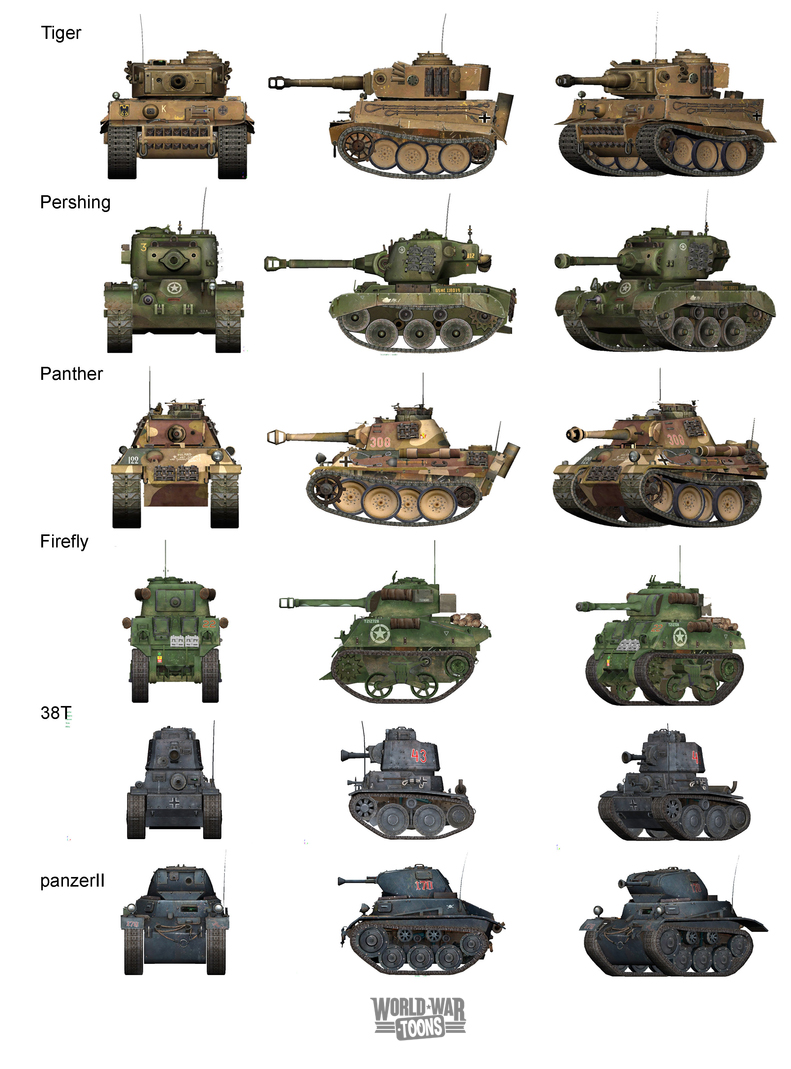
The game also makes use of power ups only one of which was in the current build of game: a radioactive container that when you pick it up makes turns your character Hulk-green and makes him super speedy, which can be a big advantage. According to Chung, the power ups serve a dual purpose, adding goofy fun as well as providing a way to balance the game. In addition to the power ups players can shoot the pigs and chickens roaming around the maps to get health back, as player health does not auto regenerate.
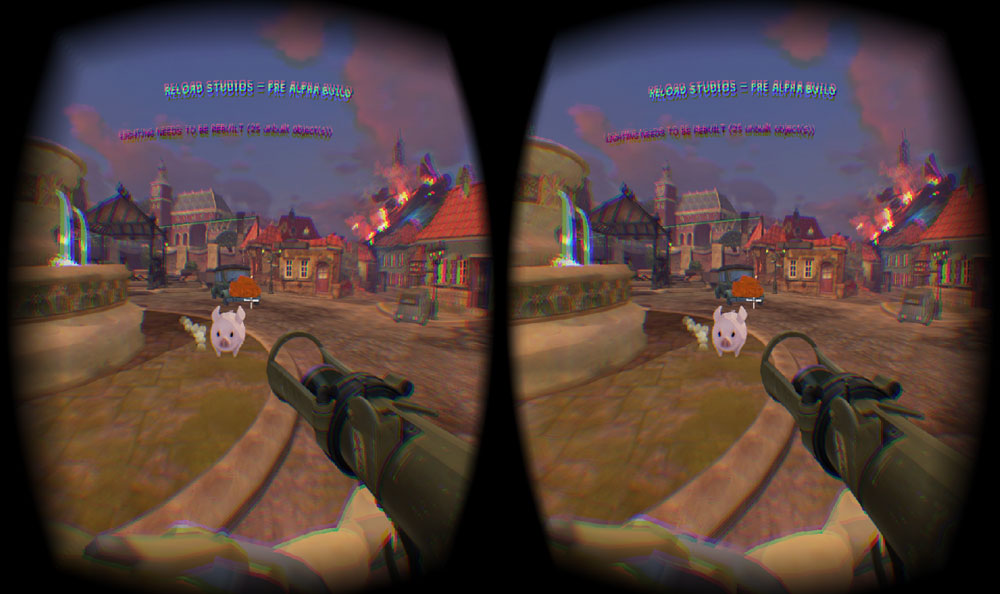
Input is also something that Reload has put a large amount of effort into figuring out. Most people play first person shooters from a seated position on the couch, a location that is not particularly conducive to whipping one’s head around 360 degrees. To solve this, Reload has been experimenting with a new control method they are dubbing “quick turn.” The quick turn method in its current state allows you to turn a full 360 degrees, without turning your head completely around, instead using quick movements to either the left or right to help whip the player around. While not a perfect solution yet, it works well and let me easily run around in the environment without having to turn around uncomfortably in the non-spinning chair I was sitting in at the BBQ joint. The sensitivity of the quick turn effect is something that can be adjusted in the settings with ‘HMD Assist.’
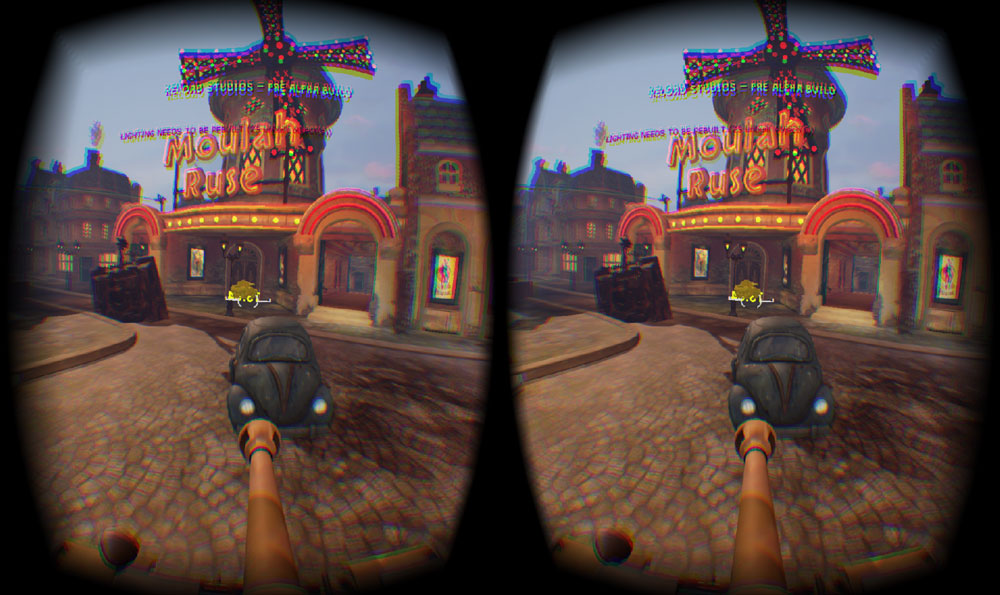
The default movement controls in the game – what Reload is calling the “Simple Control Scheme,” are fairly unconventional. Rather than using a thumbstick to move forward or backwards there are buttons assigned to forward and backward. Pressing the A button moves your character forwards and a double tap hold on the button enables the sprint functionality, B moves the player back. At first this was fairly jarring, having been a long time FPS player I found myself wanting to press forward on a thumb stick. After a while, I managed to get used to the controls, but they didn’t quite feel right for the Xbox 360 controller, this however is likely because the team is working to future proof the game for different VR controller types. For example, Reload has already announced that the game will be available on “all major VR platforms” and the Move controllers used by the Morpheus, for example, don’t have thumbsticks at all so this solves that problem (also of note, the Vive controllers don’t have thumbsticks either but as of now Reload can “neither confirm nor deny” specific support for the device). Says Chung, “we will be working with dedicated VR controllers, but we are also trying to come up with solutions that can cater to traditional input devices and this means you have to really change the way you think about moving around using traditional control schemes.”
Messing around in the game offline I was able to find a traditional control scheme in the settings that made the game play more traditionally on the 360 controller. In the default simple control scheme, the aiming is done with your head, with control sets that give you the ability to look along the x-axis with the thumb stick but locks the y-axis to the HMD. The team is still experimenting with finding the best control scheme but this is a great start.
So, why did I bother mentioning the BBQ joint story at the beginning of this piece? First of all, it was too ridiculous not to share. More importantly however, it really shows how lean and mean this game is. The WiFi connection that I was on was weak to say the least, yet I was still able to run the game on a macbook (running bootcamp) and only had a few hangups with lag on the WiFi. The game was fast and responsive, even online in a full server with a bad wireless connection on a laptop.
For Reload, this project is about returning to their roots, when Chung and his partner started out they were both working on games in the WWII genre. While the approach they have taken is very different than past WWII first person shooters, it is the start of something that has the potential to be pretty amazing. Even in its currently buggy state (which is completely understandable given its stage in development), the game is extremely fun to play and at no point did I feel the slowing down of the game as a hindrance. One of the things that makes this project so special is that it was built from the ground up specifically for VR, which is why it manages to succeed so well where other attempts have failed.
So what’s next for Reload? They will be beginning a public alpha of the game some time around E3. In between now and then they are planning to continue working on the animations and the balancing the gameplay as much as possible. Looking into the future, Chung mentioned “we would love to do another realistic WWII shooter too,” so people who were hoping for a realistic WWII COD style game, you can continue to hold out faith that it will be coming. Chung also mentioned that the company has “2 internal projects in the plan” for VR so it seems World War Toons will be the first of many entries from Reload into the VR space, and if this is their initial benchmark we have plenty of reason to get excited.
Some more screen shots from the game:

